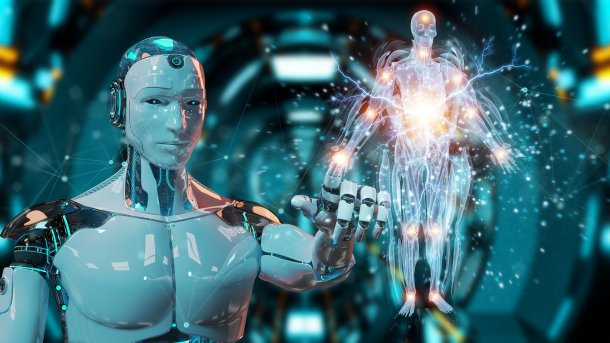Early detection: New Google AI should be able to hear diseases
Google is training an AI model to recognize signs of diseases such as tuberculosis based on sound signals such as coughing, sneezing and breathing noises.

(Image: sdecoret / Shutterstock.com)
A new bioacoustic artificial intelligence (AI) model developed by Google could significantly improve the early diagnosis of certain diseases. The suspicion of tuberculosis (TB) and other serious lung diseases such as COPD (chronic obstructive pulmonary disease) or other respiratory infections could be incorporated even better into early diagnosis by simple means, while minimizing the burden on patients. The effort would be equivalent to recording a voice memo.
The internet company has named the initiative Health Acoustic Representations (HeAR). According to the company, it is training this AI model to detect early signs of illness based on sound signals such as coughing, sneezing or sniffling. "The sounds our bodies make are full of information about our state of health," Shravya Shetty explains, Technical Director at Google Research. "Subtle clues hidden in these bioacoustic sounds hold the potential to revolutionize" the way various diseases are studied, diagnosed, monitored and treated.
According to Shetty, the Google research team trained HeAR using 300 million pieces of audio data "compiled from a diverse and anonymized dataset". The cough model in particular was trained using around 100 million coughing sounds. HeAR searches for patterns in health-relevant sounds and thus forms a "powerful basis for medical audio analysis". The technology, which can be used via smartphone microphones, for example, could revolutionize diagnosis, especially in areas where advanced instruments are difficult to access.
Cooperation with Indian start-up
The tech giant is working with the Indian AI start-up Salcit Technologies, which specializes in respiratory diseases. The latter has developed its own program called Swaasa, which uses AI to analyze coughing sounds and assess the lungs. According to Google, the company is currently testing how HeAR can help expand the capabilities of its bioacoustic AI models. Initially, Swaasa is using Google's process to research and improve early TB detection based on coughing sounds.
Tuberculosis is "a treatable disease, but millions of cases go undiagnosed every year," explains Shetty. This is often because people "do not have convenient access to health services". Better diagnosis is crucial for the eradication of TB. With Saasa, Salcit has already gained experience in using machine learning for early disease detection and bridges the gap between accessibility, affordability and scalability. This is because the start-up offers a location-independent, device-free assessment of respiratory health. With HeAR, the company now sees an option to expand TB screening throughout India
Organizations such as the StopTB partnership based at the United Nations also support HeAR, reports Shetty. This brings together tuberculosis experts and affected communities with the aim of eliminating tuberculosis by 2030.
Corona detection apps made the start
In principle, the approach is not new. In 2020, for example, researchers at the University of Cambridge developed a smartphone app that can automatically detect whether a user has Covid-19 based on the sound of their voice, breathing and coughing. Shortly afterward, Swiss researchers declared that they had found a tool with two deep learning algorithms they had developed to identify coronavirus infections even when there are no symptoms in lung images and breathing sounds. Other experts worked in parallel with Augsburg University Hospital on an app that detects coronavirus infection as quickly as possible based on speech.
"On average, HeAR performs better than other models in a variety of tasks and in generalization across microphones," Google emphasizes. This points to an outstanding ability to "capture meaningful patterns in health-related acoustic data". Models trained with HeAR achieved high performance even with less training data, which is a decisive factor "in the often data-poor world of health research".
(nie)